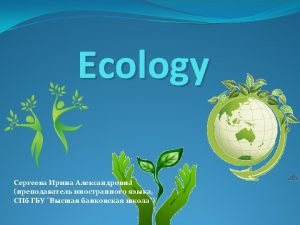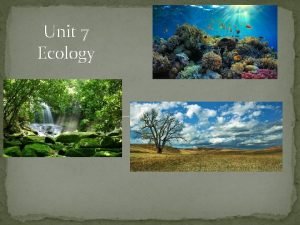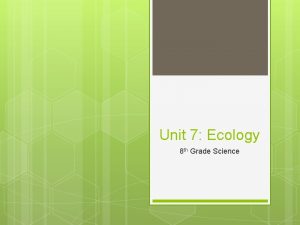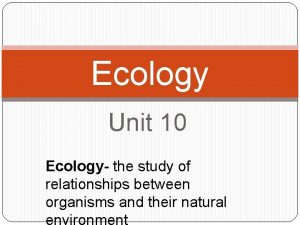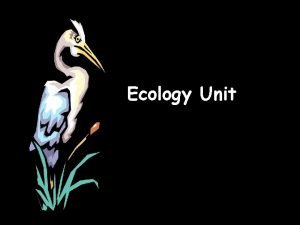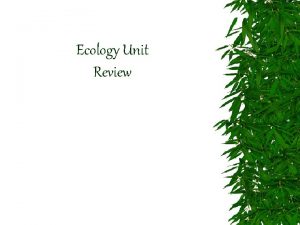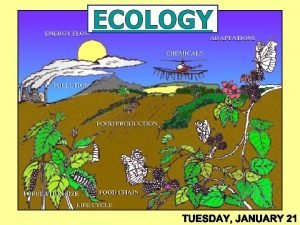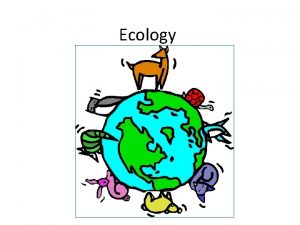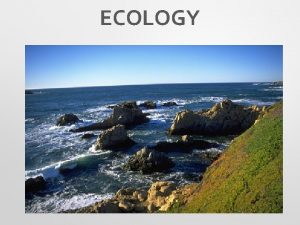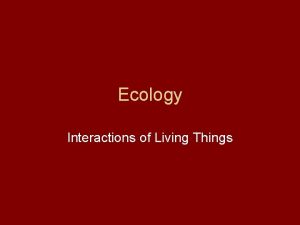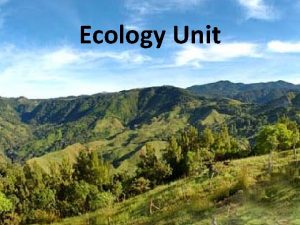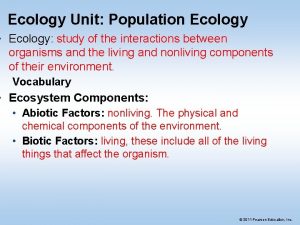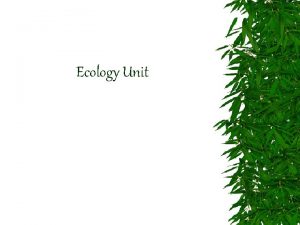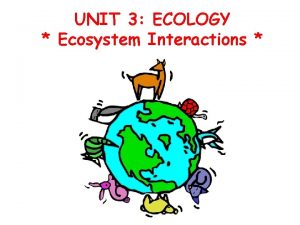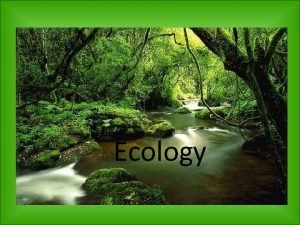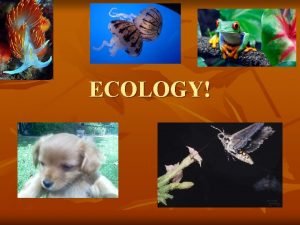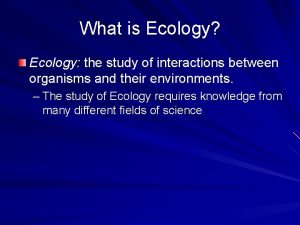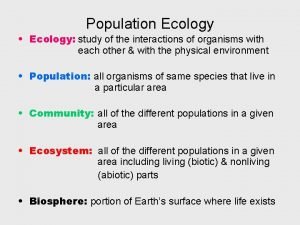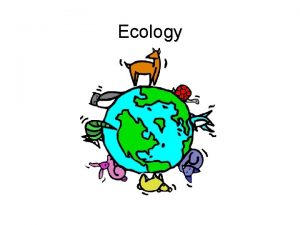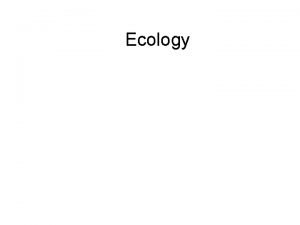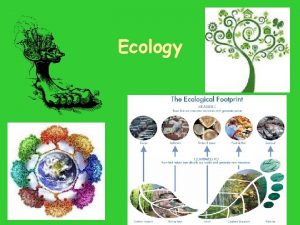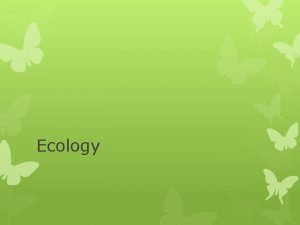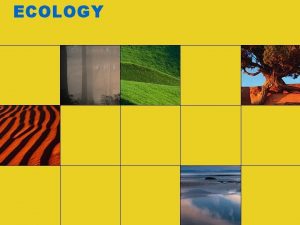Unit 7 Ecology Ecology the study of interactions





















- Slides: 21

Unit 7 Ecology

• Ecology- the study of interactions between organisms and their environments • The environment is made up of two factors: • Biotic factors- all living/once living organisms inhabiting the Earth • Abiotic factorsnonliving parts of the environment (i. e. temperature, soil, light, moisture, air currents)

Biosphere Ecosystem Community Population Organism

Organism Anything exhibiting all of the characteristics of life as an individual. • The lowest level of organization in ecology

Population a group of individual organisms of one species living in the same place at the same with the ability to interbreed.

Community Interacting populations that inhabit a common environment and are interdependent. (All biotic components in an ecosystem)

Ecosystem All the biotic and abiotic components interacting with each other.

Biosphere The life supporting portions of Earth composed of air, land, fresh water, and salt water. • The highest level of organization • The Biosphere is composed of many Biomes

Habitat vs. Niche • Habitat- the place in which an organism lives out its life • Niche - the role a species plays in a community (job) • A niche is determined by a limiting factor. • Limiting factor- any biotic or abiotic factor that restricts the existence of organisms in a specific environment. • Examples of limiting factors • Amount of water, food, Temperature

�Carrying Capacity �the maximum population size that can be supported by the available resources �There can only be as many organisms as the environmental resources can support N S-shaped curve (logistic growth) u m b e r Carrying Capacity (k) J-shaped curve (exponential growth) Time

Feeding Relationships There are 4 main types of organisms in ecosystems 1. Producer- all autotrophs (plants), they trap energy from the sun to make food (sugar). • Bottom of the food chain 2. Consumers- all heterotrophs: they ingest food containing the sun’s energy

3. Scavengers/Detritivores �Feed on dead animals and plants but do not return nutrients back into the soil 4. Decomposers �Decomposers breakdown the complex compounds of dead and decaying plants and animals and return nutrients back into the soil (Bacteria & Fungi)

� Food Chain � Shows the flow of energy from one trophic level to the next � Food Web � � shows all possible feeding relationships in a community at each trophic level Represents a network of interconnected food chains

Trophic Levels �Each link in a food chain is known as a trophic Autotrophs Heterotrophs level. �Trophic levels represent a feeding step in the transfer of energy and matter in an ecosystem. Carnivores/ Omnivores Herbivores

Population interactions Competition – Occurs when resources are limited and organisms seek to utilize this common resource • Interspecific – Competition between two different species • Intraspecific- Competition within the same species

Population interactions � Mutualism – Symbiotic relationship where two organisms live together and both benefit. � Parasitism- Relationship where one organism benefits at the expense of the other (lives on or in another organism) � Predation- One organism hunts and eats another organism

Nutrient Cycles • Cycling maintains homeostasis (balance) in the environment. • 3 cycles to investigate: 1. Water cycle 2. Carbon cycle 3. Nitrogen cycle

Water cycle – Driven by sunlight energy. Important processes include… • Evaporation • Transpiration • Condensation • Precipitation

Carbon cycle Photosynthesis and respiration cycle carbon and oxygen through the environment.

Nitrogen cycle • • Atmospheric nitrogen (N 2) makes up nearly 80% of air. Organisms can not use it in that form. Lightning and bacteria convert nitrogen into usable forms. Nitrogen fixation-convert atmospheric nitrogen (N 2) into ammonium (NH 4+) which can be used

Land Biomes �Biome- geographic areas that have similar climates and ecosystems �The 6 most common biomes are: �Tundra �Taiga �Temperate Deciduous Forest �Tropical Rain Forest �Grassland �Desert
 Ecology study guide
Ecology study guide Main idea youtube
Main idea youtube Ecology is the study that helps to preserve
Ecology is the study that helps to preserve Unit 6 review questions
Unit 6 review questions Unit 7 ecology
Unit 7 ecology Unit 7 ecology answer key
Unit 7 ecology answer key Which of the following tells you population density
Which of the following tells you population density Biological magnification
Biological magnification Ecology unit review
Ecology unit review Sulfur oxide
Sulfur oxide Hát kết hợp bộ gõ cơ thể
Hát kết hợp bộ gõ cơ thể Slidetodoc
Slidetodoc Bổ thể
Bổ thể Tỉ lệ cơ thể trẻ em
Tỉ lệ cơ thể trẻ em Voi kéo gỗ như thế nào
Voi kéo gỗ như thế nào Thang điểm glasgow
Thang điểm glasgow Hát lên người ơi alleluia
Hát lên người ơi alleluia Các môn thể thao bắt đầu bằng từ đua
Các môn thể thao bắt đầu bằng từ đua Thế nào là hệ số cao nhất
Thế nào là hệ số cao nhất Các châu lục và đại dương trên thế giới
Các châu lục và đại dương trên thế giới Công thức tính thế năng
Công thức tính thế năng Trời xanh đây là của chúng ta thể thơ
Trời xanh đây là của chúng ta thể thơ


